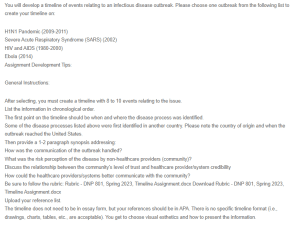Timeline of Events Related to the HIV and AIDS Outbreak Between 1980 and 2000
This timeline outlines significant events related to the HIV and AIDS outbreak between 1980 and 2000. The timeline begins with identifying the disease process and covers major global and United States response milestones.
Timeline
| Year | Event |
| 1981 | First Cases Identified – The first cases of what would later be called AIDS emerged in the United States among five young men who were previously in good health and were homosexuals residing in Los Angeles (CDC, 2021). |
| 1982 | Disease Named AIDS – The disease is officially named Acquired Immunodeficiency Syndrome (AIDS) by the CDC (CDC, 2021). |
| 1983 | HIV Identified as Cause – French scientists discover HIV as the cause of AIDS (World Health Organization, 2019). |
| 1985 | First HIV Blood Test – The FDA approves the first commercial blood test for HIV, allowing the screening of potential blood donations. |
| 1987 | AZT Approved – The FDA approves AZT, the first antiretroviral drug for HIV/AIDS treatment. |
| 1991 | Red Ribbon Introduced – The red ribbon is adopted across the globe to raise awareness of AIDS. |
| 1994 | AZT Reduces Mother-to-Child Transmission – A study indicates that AZT can reduce the chances of transmission of HIV from mother to child by a third. |
| 1996 | HAART Introduced – Highly Active Antiretroviral Therapy (HAART) is introduced to help people living with HIV/AIDS, boosting existing standards of living for individuals experiencing the disease. |
| 1997 | Global AIDS Epidemic – The cases of HIV/AIDS victims go over twenty two million all over the world. |
| 2000 | UN Declares AIDS a Security Issue – The UN Security Council recognizes HIV/AIDS as a threat to global security, underscoring its impact on nations. |
Synopsis
The outbreak of HIV/AIDS was first characterized by confusion and stigmatization of the affected individuals, especially in the early stages of the disease, as noted by Taggart et al. (2021). The general populace was scared of mass, and that was enhanced through rumors and prejudice, especially towards gay men and IV drug users. There was no specific direction given by health sector organizations, resulting in panic and stigmatization. Consequently, confidence in the healthcare workers and the health facilities was eroded since a large section of the population believed that the disease was either overly dramatized or not well acknowledged.
Subsequently, communication over time became more fruitful as more information was put into the public domain, and through better-determined public health and awareness campaigns, fear was reduced and understanding improved. Thus, these were crucial to the evolving understanding of the dreaded disease and the creation of a more accepting environment with activities like the red ribbon symbol or World AIDS Day. However, the ill effects of initial poor communication remained unheeded for years to come. From here on, more efforts should be appended toward community mobilization and timely dissemination of facts about such illnesses by healthcare stakeholders and systems in an attempt to cut down on the existence of stigmatized diseases such as HIV/AIDS, as seen from the study of Kumah et al. (2023). More specifically, there should be more focus on the transparency of information, the update of contents, and the active involvement of the community to regain and consolidate trust.
References
CDC. (2021, March 26). The AIDS epidemic in the United States, 1981-early 1990s | David J. Sencer CDC Museum | CDC. Www.cdc.gov. https://www.cdc.gov/museum/online/story-of-cdc/aids/index.html
Kumah, E., Boakye, D. S., Boateng, R., & Agyei, E. (2023). Advancing the global fight against HIV/Aids: Strategies, barriers, and the road to eradication. Annals of Global Health, 89(1). https://doi.org/10.5334/aogh.4277
Taggart, T., Ritchwood, T. D., Nyhan, K., & Ransome, Y. (2021). Messaging matters: Achieving equity in the HIV response through public health communication. The Lancet HIV, 8(6), e376–e386. https://doi.org/10.1016/S2352-3018(21)00078-3
World Health Organization. (2019, October). HIV/AIDS. World Health Organization: WHO. https://www.who.int/health-topics/hiv-aids
ORDER A PLAGIARISM-FREE PAPER HERE
We’ll write everything from scratch
Question
You will develop a timeline of events relating to an infectious disease outbreak. Please choose one outbreak from the following list to create your timeline on:

Timeline of Events Related to the HIV and AIDS Outbreak
H1N1 Pandemic (2009-2011)
Severe Acute Respiratory Syndrome (SARS) (2002)
HIV and AIDS (1980-2000)
Ebola (2014)
Assignment Development Tips:
General Instructions:
After selecting, you must create a timeline with 8 to 10 events relating to the issue.
List the information in chronological order.
The first point on the timeline should be when and where the disease process was identified.
Some of the disease processes listed above were first identified in another country. Please note the country of origin and when the outbreak reached the United States.
Then provide a 1-2 paragraph synopsis addressing:
How was the communication of the outbreak handled?
What was the risk perception of the disease by non-healthcare providers (community)?
Discuss the relationship between the community’s level of trust and healthcare provider/system credibility
How could the healthcare providers/systems better communicate with the community?
Be sure to follow the rubric: Rubric – DNP 801, Spring 2023, Timeline Assignment.docx Download Rubric – DNP 801, Spring 2023, Timeline Assignment.docx
Upload your reference list.
The timeline does not need to be in essay form, but your references should be in APA. There is no specific timeline format (i.e., drawings, charts, tables, etc., are acceptable). You get to choose visual esthetics and how to present the information.

